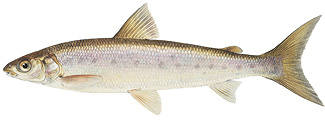Round Whitefish
Prosopium cylindraceum
 Distribution: The round whitefish is found throughout northeast Asia, northwestern North America, eastern Canada, the northeastern U.S., and in all of the Great Lakes except Lake Erie. It is absent from central and southwestern Canada. In New Hampshire the species is limited to two waterbodies: Newfound Lake and the upper Connecticut River.
Distribution: The round whitefish is found throughout northeast Asia, northwestern North America, eastern Canada, the northeastern U.S., and in all of the Great Lakes except Lake Erie. It is absent from central and southwestern Canada. In New Hampshire the species is limited to two waterbodies: Newfound Lake and the upper Connecticut River.
The round whitefish has been documented in the Connecticut River from the Lake Francis Dam south to the bridge at North Stratford. Prior to the construction of the Lake Francis Dam, round whitefish were captured in 1939 in the section of river now flooded by the lake. Round whitefish were also said to have been abundant in First Connecticut Lake prior to 1929. There have been no recent reports of round whitefish in Lake Francis or the Connecticut Lakes.
Description: The round whitefish is a long, cylindrical fish with a small, laterally compressed mouth and a somewhat pointed snout. Its head is relatively small compared to the length of its body. Its large scales are golden brown above, fading to white below and its caudal fin is deeply forked. There is a single flap of skin between the nostrils, which distinguishes it from the lake whitefish. Juvenile round whitefish have a row of black spots, or parr marks. Spawning individuals grow bumpy tubercles, more prominent in males than females. Average length is 8 to 12 inches, with a maximum length up to 22 inches. Individuals of up to 19 inches in length have been captured in Newfound Lake. Adults rarely reach more than 13 years of age.
Species commonly confused with: Lake whitefish
Habitat: At the southern end of their range round whitefish usually inhabit medium to large sized lakes with deep, cold water habitat. They spawn in shallow water over cobble and gravel substrate. Round whitefish also inhabit medium to large sized cold-water rivers. Riverine populations are more common in the northern parts of its range.
There is little information on the seasonal habitat use of round whitefish in the Connecticut River or in Newfound Lake. Electrofishing surveys on the Connecticut River suggest that round whitefish are more common in areas of gravel substrate and steady current compared to reaches with slow flow and silt bottom. Spawning activity has been documented on one reef in Lake Newfound, but the extent of spawning activity or habitat use throughout the rest of the lake is poorly understood.
Life History: In Newfound Lake, round whitefish are known to spawn on a shallow reef off of Pike’s Point, at the southern end of the lake. The reef is kept clear of sediment by the wave action resulting from strong northwest winds. Much of what is known about round whitefish in Newfound Lake is owed to the doctoral research of Donald Normandeau in 1963.
Dr. Normandeau documented spawning beginning in late November, with a peak in the second week of December. Males and females approached the reef in pairs, not in large schools as is common with other species. The eggs received no parental care and hatched from the end of March to the beginning of May. Egg predation by species such as brown bullhead, burbot, white sucker, and yellow perch appeared to be a significant cause of mortality over the winter.
Round whitefish are bottom feeders, preying mainly on benthic invertebrates and fish eggs or newly hatched fry. Although found in deep lakes, they rarely inhabit depths greater than 120 feet. There are anecdotal reports of round whitefish movement into the tributaries of Newfound Lake in the early spring, possibly in response to the availability of prey.
Origin: Native
Conservation/Management: The round whitefish is listed as endangered in New York, where it was once common in the lakes of the Adirondacks. Low pH due to acid rain and introduced predators were the main causes of decline. Smallmouth bass and yellow perch reduce round whitefish numbers directly through predation, while juvenile smelt compete with juvenile round whitefish for food. All three of these species coexist with round whitefish in Newfound Lake, although smallmouth bass were the most recently introduced.
Gill nets set on a cobble reef off of Pike’s Point during the round whitefish spawning season have produced alarmingly few round whitefish since surveys began in 2005. The large size of the individuals captured on the spawning reef suggests that there may be very little recruitment of juvenile round whitefish occuring in Newfound Lake. Only 5 round whitefish were captured in an intensive gill netting survey conducted throughout Newfound Lake in 2015. Since then, no round whitefish have been captured on the spawning reef. It appears that the round whitefish may be on the verge of extirpation (if not currently extirpated) from Newfound Lake, possibly as a delayed result of the introduction of smallmouth bass, which occurred in 1968.
Recent surveys for round whitefish in the upper Connecticut River suggest that the species is relatively abundant in the reach from the bridge in Colebrook north to the Canaan Dam. The presence of both juveniles and adults in this reach suggests that the species is reproducing successfully. Cold water released from the base of the Lake Francis Dam may be an important factor in maintaining the round whitefish population in the river. The habitat needs and the actual distribution of the round whitefish in the upper Connecticut River remain poorly understood.



